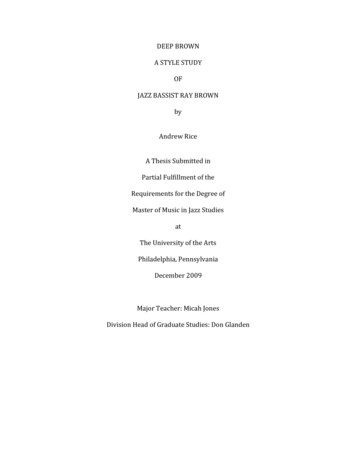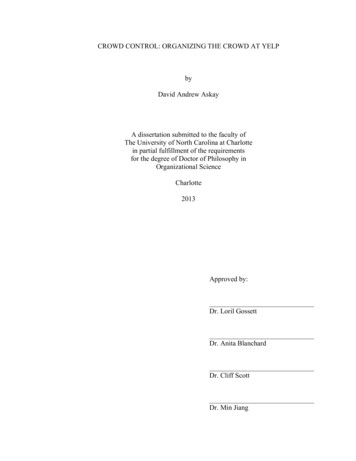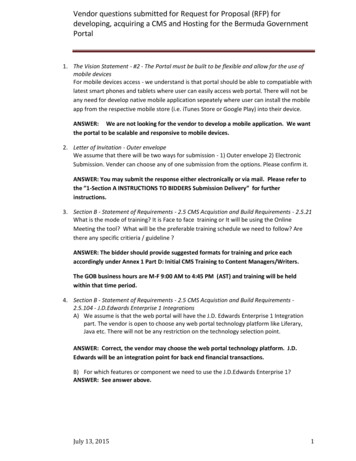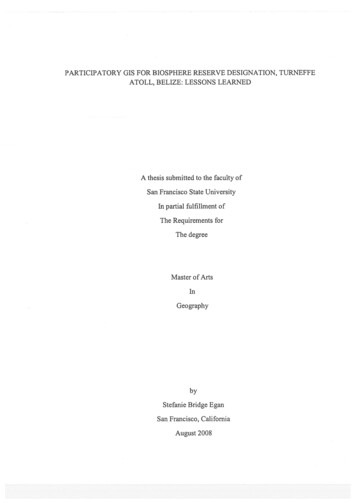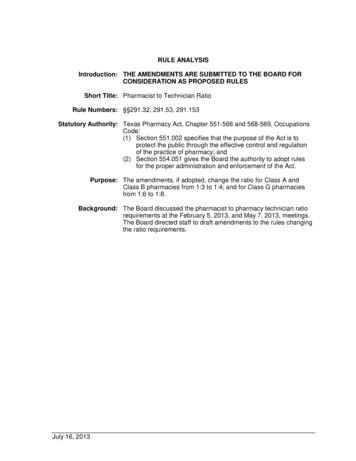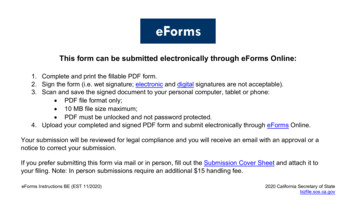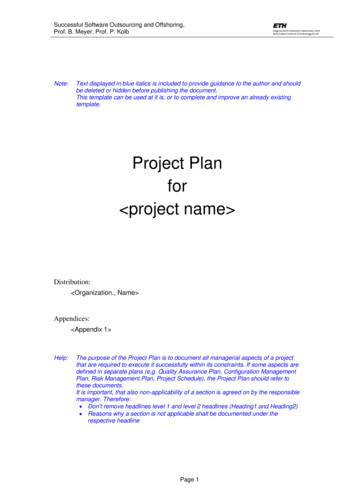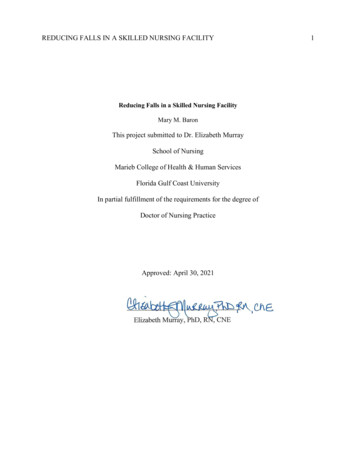
Transcription
REDUCING FALLS IN A SKILLED NURSING FACILITYReducing Falls in a Skilled Nursing FacilityMary M. BaronThis project submitted to Dr. Elizabeth MurraySchool of NursingMarieb College of Health & Human ServicesFlorida Gulf Coast UniversityIn partial fulfillment of the requirements for the degree ofDoctor of Nursing PracticeApproved: April 30, 20211
REDUCING FALLS IN A SKILLED NURSING FACILITY2Table of ContentsAbstract . 4Introduction . 6Significance. 6Relevance . 8Problem Statement . 8Local Problem . 8Clinical Question – PICOT Question . 9Search Methods . 9Available Knowledge/Review of the Literature . 11Causes of Falls . 12Risk Factors . 14Interventions to Prevent Falls . 15Specific Aims/Purpose . 19Theoretical Framework . 19Methods. 21Context . 21Innovation/Intervention(s) . 22Outcome Measure . 27Ethical Considerations . 28
REDUCING FALLS IN A SKILLED NURSING FACILITY3Results . 28Discussion . 29Implications of Covid-19 Pandemic . 29Key Findings . 30Project Strengths . 31Interpretation . 32Limitations . 33Sustainability. 34Conclusions . 34References . 37Appendix A: Evidence Appraisal Table . 46Appendix B: Project Synthesis Matrix . 62Appendix C: Project Timeline . 75Appendix D: Top 5 Fallers Report Sheet . 76
REDUCING FALLS IN A SKILLED NURSING FACILITY4AbstractBackground: Unintentional falls are a significant threat to the health and safety of nursinghome/skilled nursing facility residents. Approximately 75% of residents of nursing homes fallannually, which is more than double the rate of community-dwelling older adults. One in fivefalls causes serious injury such as broken bones or head injury.Purpose: The purpose of this quality improvement project was to determine the effectiveness ofa multi-dimensional fall prevention protocol in reducing falls in a skilled nursing/long-term carefacility (the “Facility”) in Southwest Florida.Methods: Based on an in-depth review of the literature, a Multi-Dimensional Fall Prevention(MDFP) Protocol was created and included four interventions with rationales based on bestevidence. The MDFP Protocol was implemented in September 2020 as a supplement to the fallprevention interventions that were currently in place on three long-term care floors of theFacility. Aggregated fall data was collected after implementation and compared to aggregatedfall data during the same period in 2019.Results: Overall, the number of falls increased 1% from 2019. On the third floor the decreasewas 23% and on the fourth floor the decrease was 40%. However, on the second floor, there wasa 63% increase in the number of falls which may have skewed the overall number. One possibleexplanation for this is a change in leadership on that floor.Conclusions: The results of this quality improvement project suggest that a multi-dimensionalfall prevention protocol effectively decreases the number of falls in long term care. In addition,effective and consistent leadership may also need to be considered when implementing a newprotocol.
REDUCING FALLS IN A SKILLED NURSING FACILITYKeywords: falls, skilled nursing facility, nursing home, older adults, fall prevention, fallreduction, fall protocol, long-term care, multi-dimensional, overnight briefs, overnightawakenings, nurse report, CNA report, anti-hypertensive medications, diuretics, proton pumpinhibitors, thyroid medication, PDSA, quality improvement, bedside report, multi-disciplinary5
REDUCING FALLS IN A SKILLED NURSING FACILITY6Reducing Falls in a Skilled Nursing FacilityUnintentional falls are a significant threat to the health and safety of nursing home/skillednursing facility residents. One in five falls causes serious injury such as broken bones(including hip fracture) or head injury (Centers for Disease Control and Prevention [CDC], 2017)and according to the CDC National Center for Injury Prevention and Control [NCIPC] (2020),approximately 30% result in hospitalization. The fact that so many falls result in injury, fear,and a decreased quality of life makes the reduction of such incidents a priority in thesefacilities. Falls among the older adult population are significant, not only due to theirprevalence, but also the ramifications in terms of the physical, emotional, and financial cost onpatients, families, providers, and the healthcare system overall. According to the CDC (2017),once a person falls, whether injured or not, they develop a fear of falling, which takes anemotional toll, resulting in a decrease in activity level and therefore a decrease in strength, whichcan cause an increased risk of another fall. In long term care facilities, including skilled nursingfacilities, the population tends to be frailer than the general population and is at particularly highrisk for falls and the resulting injury (American Geriatrics Society [AGS], 2001). Florence et al.(2018) estimated that, in 2015, the medical costs due to fatal and nonfatal costs were estimated at 50 billion.SignificanceGiven the significance of the frequency and outcomes of falls in the elderly, a large bodyof evidence is available that discusses this topic, including the identification of causes and riskfactors as well as prevention measures. Overall, there was consistency among the studies in riskfactors for falls, including patient characteristics of: older age (Baus et al., 2017; Bor et al., 2017;AGS, 2001); decreased muscle mass and strength (Van Ancum et al., 2018; Baus et al., 2017;
REDUCING FALLS IN A SKILLED NURSING FACILITY7AGS, 2001; National Institute for Health and Care Excellence [NICE], 2019); the use of certainmedications (Bor et al., 2017; Cameron et al., 2018; AGS, 2001; NICE, 2019; Callisaya et al.,2014; Agency for Healthcare Research and Quality [AHRQ], 2017a; Tinetti et al., 2014; Beasley& Patananian, 2009; Hill et al., 2007; Lapumnuaypol et al., 2019; Lewis et al., 2014; Thaler &Van Der Cammen, 2016; Taylor & Hignett, 2016); orthostatic hypotension (AHRQ, 2017a;Shaw, et al., 2019); frailty (Shaw et al., 2019; NICE, 2019); vision and other sensory impairment(Cameron, et al., 2018; AGS, 2001; NICE, 2019; Brassington et al., 2000; Hill et al., 2007; );resident-to-resident violence (Teresi et al., 2018); arthritis diagnosis (Baus et al., 2017; AGS,2001; Brassington et al., 2000); epilepsy diagnosis (Baus, et al. 2017); impaired gait, balance ormobility (Bowen & Rowe, 2016, AGS, 2001; AHRQ, 2017a; Brassington et al., 2000; Hill, et al.,2007; NICE, 2019); and cognitive impairment (Cameron et al., 2018; Baus et al., 2017; Whitneyet al., 2017; AGS, 2001; AHRQ, 2017a; NICE, 2019). In addition, factors in the externalenvironment of the facility can contribute to falls (Taylor & Hignett, 2016; AHRQ, 2017a; AGS,2001). Lastly, there are factors related to the facility personnel, policies and procedures that canaffect the risk of falls (Taylor & Hignett, 2016, AHRQ, 2017a; AGS 2001).Interventions to improve fall rates have been numerous and vary by patient traits andfacility type and include: exercise programs alone (Rimland et al., 2016; Sherrington et al., 2017;Fien et al., 2019); multi-dimensional protocols (Rimland et al., 2016.; AGS, 2001; Roigk et al.,2018; Lee & Kim, 2017; Whitney et al., 2017; NICE, 2019; Choi et al., 2011); facility designchanges (Taylor & Hignett, 2016; Rimland et al., 2016); facility personnel changes (Taylor &Hignett, 2016); podiatry interventions (Wylie et al., 2017); patient education (Heng 2019;Rimland et al., 2016); urinary continence management (Rimland et al., 2016); music (Chabot et.al, 2019); staff training (Teresi et al., 2018; NICE, 2019; AGS, 2001); virtual reality (Mirelman
REDUCING FALLS IN A SKILLED NURSING FACILITY8et al., 2016); medication review and modification (AGS, 2001; AHRQ, 2017a; Beasley &Patatanian, 2009; Choi et al., 2011; NICE, 2019; Roigk et al., 2018) and the use of sensingtechnology (Sun & Sosnoff, 2018).RelevanceResidents of nursing homes on average are older, have more mobility and cognitiveissues, have more difficulties independently performing activities of daily living, and suffer frommore chronic health issues (CDC, 2017). Skilled nursing facilities may recognize the need foradditional prevention measures; however, the solution is often not simple and may require acomprehensive protocol that incorporates several interventions, including both standardinterventions and those tailored to the individual.Problem StatementUnintentional falls are a significant threat to the health and safety of nursing home/skillednursing facility residents. The fact that so many falls result in injury, fear, and a decreasedquality of life makes the reduction of such incidents a priority in these facilities. The AHRQ(2017b) reported that approximately half of residents of nursing homes fall annually, which isapproximately double the rate of community-dwelling older adults, and of those that fall, about athird fall a second time.Local ProblemA skilled nursing facility in Southwest Florida recognized the pervasiveness of this issueand was dedicated to developing a fall prevention protocol that was in line with the most currentevidence. The Facility offered short-term as well as long term rehabilitation and skilled nursingservices by a team of dedicated caregivers. Their post-operative and other specialized careincluded the areas of cardiac, orthopedic, pulmonary, neurological, stroke, memory, dysphagia,
REDUCING FALLS IN A SKILLED NURSING FACILITY9pain management and low vision care. An advanced practice registered nurse (APRN) indicatedthat the Facility had a patient population that averaged over 85 years of age, and they werefocused on decreasing their fall rate, given that they had multiple falls in any given week(personal communication, October 6, 2019). According to the Center for Medicare andMedicaid Services (CMS) (2020), the percentage of long-term residents who fell at least oncewith a major injury was 4.3% in this skilled nursing facility, as compared to an average of 2.7%in Florida and 3.4% nationally. Their short-stay residents fared better, with a rate of 0.9%, equalto the national rate (the State of Florida’s rate is not reported).Clinical Question – PICOT QuestionThe clinical question addressed was: Will the implementation of an evidence-basedMulti-Dimensional Fall Prevention Protocol on the long-term care floors of the skilled nursingfacility affect the number of falls among their patient population greater than 65 years of age?The PICOT question was: on the long-term care floors of a skilled nursing facility inSouthwest Florida, what is the effect of a 12-week Multi-Dimensional Fall Prevention Protocolon reducing the number of falls as compared to the same period in the prior year, before theimplementation of the Protocol?Search MethodsA literature review was conducted to understand recent research on the topic of thereduction of falls in older adults in skilled nursing facilities. To design an evidence-basedintervention, it was necessary to understand methodologies, techniques, instruments, and resultsthat have historically been utilized and analyzed. A database of references was maintained, andtags were used to organize and narrow down the articles to only the most relevant. The literature
REDUCING FALLS IN A SKILLED NURSING FACILITY10review identified articles through the search engines ProQuest Central, PubMedand CINAHL for the dates 2016 through current to focus on the most recent research.The ProQuest Central search setting included only full-text peer-reviewed Englishlanguage articles. The search terms were falls prevention or preventing falls or prevent falls orreduce falls AND nursing homes or care homes or long-term care or residential care ANDINTERVENTION* OR STRATEG*. There were 1,186 resultant citations from thesearch. After the date criteria of 2016 to current was input, 457 citations remained.The PubMed search settings used truncation and Boolean operators with the search terms"falls prevention" or "fall prevention" or "preventing falls" or "prevent falls" or "reducefalls" AND INTERVENTION* OR STRATEG* AND "nursing homes" or "care homes" or"long term care" or "residential care" or "skilled nursing facility". There were 359 articles. Afterlimiting further for full-text, peer-reviewed, dated 2016 and more current, and English languageonly. After eliminating articles prior to 2016, 90 remained.Two CINAHL searches were performed. The first included the search terms fallsprevention or preventing falls or prevent falls or reduce falls AND nursing homes or care homesor long-term care or residential care. The initial search resulted 1,286 articles. After specifyingfull-text, peer-reviewed, English language, dates since 2016, the yield was 41. The secondCINAHL search was based on the search terms falls prevention or preventing falls or preventfalls or reduce falls AND nursing homes or care homes or long-term care or residential careAND INTERVENTION* OR STRATEG* and resulted in 258 articles that were reduced to 19after specifying full-text, peer-reviewed, English language and dates 2016 or later.These 607 articles were further narrowed by excluding: 1) Studies that only took place inthe emergency room; 2) interventions that took place at home and would not be able to be
REDUCING FALLS IN A SKILLED NURSING FACILITY11implemented in a skilled nursing facility; 3) protocols; and 4) studies in which falls were not amajor outcome measure. Commentaries were excluded. During the process of designing theinterventions, additional resources were sought related to risk factors and interventions. Anadditional 19 sources were added to the literature review to ensure that the interventions carriedout were fully supported by the evidence. A total of 42 articles were reviewed. Each includedarticle/study was appraised using the Johns Hopkins Nursing Evidence-Based Research andNon-Research Appraisal tools. See Appendix A, Evidence Appraisal Table, for additional detail.Available Knowledge/Review of the LiteratureAccording to the CDC’s Web-based Injury Statistics Query and Reporting System(WISQARS) database, in 2018 people aged 65 and older made over 3 million visits to theemergency room due to an unintentional fall (NCIPC, 2020). Over 32,000 of these falls werefatal (NCIPC, 2020). Given the significance of the frequency and outcomes of falls in theelderly, a large body of evidence was available including the causes of falls, interventions toprevent falls, and risk factorsUsing the Evidence Appraisal Process by The Johns Hopkins Hospital/The Johns HopkinsUniversity (Poe & White, 2010), 42 articles were assessed for their evidence level andquality. The summary of this process is depicted in Table 1 below. A Synthesis Matrix wasused to identify themes and patterns (see Appendix B).Table 1Summary of Levels of EvidenceLevel of EvidenceLevel INumber of Articles10Quality AQuality B54
REDUCING FALLS IN A SKILLED NURSING FACILITY12Level II1265Level III1355Level IV33-Level V422Total422116Causes of FallsHypotension (decreased blood pressure), urinary urgency or incontinence, nighttimeawakenings, and certain medications were found to be significant causes of falls in the elderly.HypotensionHypotension, or low blood pressure, happens due to several factors, including the use ofmedications to reduce blood pressure and the change in blood pressure that can happen whengoing from laying down to sitting or sitting to standing. Studies as well as guidelines linkedhypotension, including postural (orthostatic) hypotension, to an increased risk for falls (Baus etal., 2017; Shaw et al., 2019; AGS, 2001; AHRQ 2017a). Shaw et al. (2019), in a quasiexperimental retrospective/prospective designed study on 116 older adults living in two longterm care facilities, showed a significant relationship between the severity of the drop in systolicblood pressure and prospective falling (p 0.046). When recovering from orthostasis, the oneminute post blood pressure correlated with prospective falling (p 0.022) (Shaw et al., 2019).They also found that in patients with both frailty and orthostatic hypotension there is a verysignificant risk for falls (Shaw et al., 2019).Urinary Urgency or Inc
REDUCING FALLS IN A SKILLED NURSING FACILITY 1 . Reducing Falls in a Skilled Nursing Facility . Mary M. Baron . This project submitted to Dr. Elizabeth Murray . School of Nursing . Marieb College of Health & Human Services . Florida Gulf Coast University . In partial fulfillment of the requirements for th
